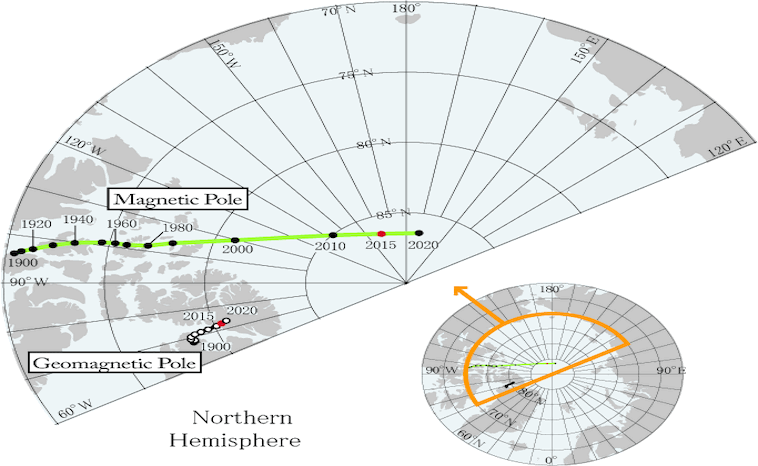Earth’s Magnetic North Shift Continues

This article updates the ongoing magnetic shift that we have been following over the past couple of years. Read on to find out what’s new and what has changed.
During the early 19th century, scientists discovered a way to measure the magnetic north. Seafarers knew about Earth’s magnetism since the 1600s when they used compasses to travel across the open sea. Magnetic north, the point on the planet’s surface toward which your conventional compass points, is created by the churning of molten metal in Earth’s core. As a result, it creates huge electrical currents to produce the magnetic field. Tracking its movement, the magnetic north has moved along over the last couple of hundred years about 600 (966km) miles. It moves about 40 miles a year and has lost about 10% of its strength over the last two centuries.

The Magnetic North Shift Continues
Recently, the British Geological Survey (BGS) and the U.S. National Oceanic and Atmospheric Administration (NOAA)updated the World Magnetic Model. The World Magnetic Model is the standard model used by governments for navigation, attitude and heading referencing systems using the geomagnetic field. Their update states that the magnetic pole continues to shift toward Siberia.
Why the concern? The coordinates for the pole affect the navigation systems of governments, military applications, and civilian populations. According to researchers, the movement will continue.
“The WMM2020 forecasts that the northern magnetic pole will continue drifting toward Russia. However, at a slowly decreasing speed. The speed has dropped to about 40 km per year compared to the average speed of 55 km over the past twenty years,” said the US agency NOAA.
The data confirmed that this year, the magnetic north pole passed to within 390 km of the geographic North Pole, and crossed the Greenwich (prime) meridian.
What Causes This Change?
Commenting on the freshly-released magnetic north pole data, Dr. Ciaran Beggan, a geophysicist and geomagnetic specialist from the British Geological Survey’s Edinburgh office stated the following,
“Although the movement of the pole has been “much faster” since the 1990s “than at any time for at least four centuries,” scientists “really don’t know much about the changes in the core that’s driving it.” Dr. Phil Livermore of Leeds University’s Institute of Geophysics added another comment.
“A ‘jet stream’ of liquid iron flowing in the planet’s core could help explain shifts in the position of magnetic north, but suggested tracking the flows of this liquid iron could be difficult, “because it lies beneath 3,000 kilometers of rock.”
What does this mean for humanity? No one knows. Speculation from scientists concludes that the shift could lead to a geomagnetic reversal. A geomagnetic reversal happens when the North and South poles switch places. The last switch happened about 800,000 years ago.
Potential Trouble Ahead
What is the worst-case scenario? Scientists believe fluctuations in the magnetic north pole would impact the magnetic field protecting Earth. Without the field, Earth would be left vulnerable to solar flares, which could cause damage to everything from spacecraft to power grids. Estimated costs for a solar flare wiping causing issues like the one in 1859? Researchers believe the damage would hit trillions of dollars and take over a decade to fix.
One thing we do know is that we cannot control the liquid iron in Earth’s core. We will continue to watch and update with news as it happens.
